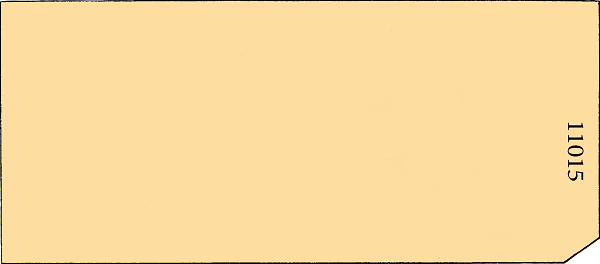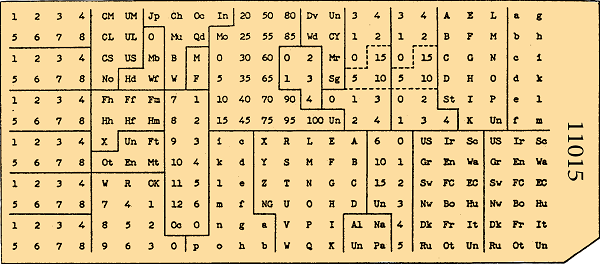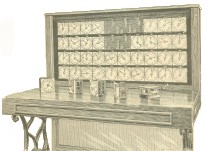Hollerith won both phases of the competition but the use of electricity gave his system an astounding
advantage when the actual tabulation was being done. His system was 8 times faster than his nearest competitor.
Nowadays, we are used to electrical gadgets but in the 1880's, Hollerith's idea was unique.
Hollerith was the first person to use electricity to compute numbers. It was so unusual that,
in 1890 the Franklin Institute, in Philadelphia, awarded Hollerith the Cresson medal and said
of Hollerith, "…the inventor is deserving of the greatest commendation for this useful and novel
application of electricity…"
2. Punch Cards
Hollerith had a second brilliant idea. He would punch holes in a card to store the information.
Each card would represent a person and the holes would represent characteristic of that person
(age, gender, occupation, etc.). The other competitors used cards to represent a person also.
However, one wrote on different colored cards for different qualities and the other used different
colored inks on his cards. Neither approach was as efficient as Hollerith's method. In fact, Hollerith's
punch cards were such an efficient storage method that for about half a century (roughly 1920 to 1970), the
cards "...held nearly all of the world's known information...".1

(Hollerith Card: This is exactly how an original Hollerith card from the 1890 census would have looked. The card had no markings other than a code number on the front and back.)

(Hollerith Card: This is a reader card which showed the coding for each potential punched hole.
Do you want to know what those codes stood for? See the
Card Codes.)
An article that appeared in the The Electrical Engineer pointed out that "…some operators handled in a single day schedules representing as many as 50,000 persons (9,200 families); and that the entire census (comprising 12,690,151 families) was counted in a period of little more than 6 weeks."2
That same article reported astounding numbers. According to the reporter, the 81 tabulating clerks working in the Department of Commerce, had "handled 556,346 cards that day, an average of 6,686 each. The "roll of honor" comprising the best individual daily records of successive weeks, ranges from 9,230 (with 4 readings) up to 13,356 (with 9 readings) with the highest individual record for a single day standing at 19,071 (with 9 readings)".
These cards were commonly known as Hollerith Cards until the 1920's when they became known as IBM cards. Although the cards were
amazingly simple (as many great ideas are), they became the foundation for IBM's success. Even into the mid-1950's, the Hollerith punch card
made up 30 percent of of IBM's annual bottom line revenue. 3
In the very beginning, as Hollerith was still developing the Electric Tabulating System, he used something we still
see today, a train conductor's holepunch, to punch holes in the cards. Hollerith described the process; "The holes may be punched with any ordinary ticket punch,
cutting a round hole 3/16 of an inch in diameter." However, as he punched more and more cards, it became
obvious that the train conductor's holepunch was a poor choice because the user's hand would quickly cramp up. So Hollerith developed a pantagraph for the 1890 census.
In 1901, he would develop a more efficient machine for punching holes in the cards, the Type 001 Keypunch.
Hollerith's Electric Tabulating Machine Company eventually became IBM.
1 IBM 100: Icons of Progress, http://www-03.ibm.com/ibm/history/ibm100/us/en/icons/punchcard/.
2 The Electrical Engineer, November 11, 1891.
3 IBM 100: Icons of Progress, http://www-03.ibm.com/ibm/history/ibm100/us/en/icons/punchcard/.
|
|



